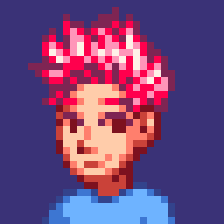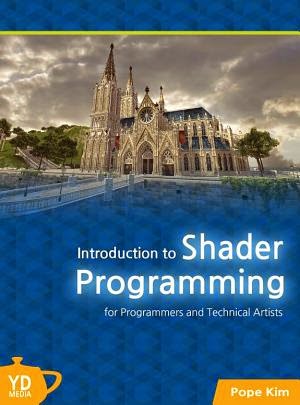00. Introduction
This book is a collection of lecture materials I developed and used to teach a shader programming course at the Art Institute of Vancouver between 2007 and 2009.
I started to work on this book back in 2010 without knowing for sure if I want to publish this book or just release it online. But before finish writing this book, a South Korean publisher wanted to publish this book in South Korea, so I had to stop it to work on the Korean version first.
Now the Korean version is out, and selling pretty well: in fact, it made its way to the best seller in computer programming category and has been picked up by a number of computer science universities and game schools as the textbook for their shader programming classes. So I thought it is time to come back to where it all started and finish the unfinished business.
I am still not sure whether I want to publish this book or not. If there is any publisher who wants to publish this easy-to-follow introductory shader programming book for both programmers and technical artists, feel free to contact me.
Why I Wrote This Book
When I was starting to teach in 2007, I was looking for a decent text book that can teach college students how to program shader language. Unfortunately, I could not find one and I believe there is still none out there. All the shader books out there focus more on advanced techniques, which are good for intermediate-to-advanced graphics programmers like me. It was very obvious to me that these books would rather scare off most college students than excite them. Sure, most DirectX books contain some introductory shader programming material, but I found none of those were very useful for the following reasons:
- In those books, shader is a second-class citizen; they only touch the surface
- They are too academic and often put too much focus on theory and syntax
- They have too many examples which have no real-world use
- They consist of too many pages to cover both DirectX and Shaders, which sacrifice portability of the book and increase the price unnecessarily. 600~1000 pages? Jees.
So what did I do? I started to teach without any textbook. I truly believe that students should get their hands dirty first to find fun in any new programming language, so I somewhat ignored a lot of theory or maths and rather focused more on practical techniques or other basic materials that will eventually lead to other practical techniques. One great thing about teaching at a college is that you find things that students have hard time understanding while you have been taking them granted. This really helped me refine my teaching method again and again, and the result is this book.
My shader programming course was picked as one of the best courses offered in the school for 3 years, so I have no doubt this book will help anyone who wants to learn shader programming. Some of my students used the demo they made in my class as part of their portfolio and managed to get jobs at various game companies, including big ones like Ubisoft and Electric Arts, so I can say I did not do such a bad job there, eh? :P
I stopped teaching after December 2009 to focus on my day-time job, game programming, but it kept bothering me that this material would never see the light ever again. So, I decided to make a book out of it. I hope anyone who wants to learn the black art of shader programming finds this book very useful.
What Is Special about This Book?
As I did in my class, this book follows these simple rules:
- Get your hands dirty: Of course, you cannot complete ignore maths or theories when you write shader code. But I found coding-first-and-learning-theories-later is a much better way to learn shader programming. You have to question yourself first 'why does it work this way?' and then get the answer by learning theories. Once you learn any theory this way, you never forget. Therefore, this book is all about code-first approach. Just follow the book as you code. It will tell you background theories here and there whenever necessary. After a while, you will find yourself be able to not only write shader codes but also understand a good amount of theories behind it.
- Easy real-world explanation: I even had some game art students listening in my lectures, and I wanted them to understand my lectures easily, too! What both artists and programmers can understand is real-world examples, so I tried my best to do the same thing in this book. Keen readers might find something that is not 100% correct in theory. This is most likely intentional in order to make the material easier to understand. (But, sometimes, it will be because I do not even understand the theories 100%. I tend to think computer graphics is a big giant trick show that makes human eyes believe it is real, so as long as it is not obviously wrong and the end result “looks” same as the correct one, I do not make a big fuss out of it.)
- Strictly for beginners: This book is strictly for beginners. I do not see any reason to compete against tons of great shader books already out there for advanced readers. I also want this book to be very compact: it should not cost a fortune to start to learn. Once you find shader programming fun after reading this book, go ahead and read other great books to adventure further, and if you find some amazing new techniques, do not forget to email me about it. :-)
- Order matters: Another blessing of teaching at a college was that I had a full control over the order of learning. This book assumes the same; you should read this book from beginning to the end in order. I will not repeat something I explained in the previous chapters. For example, while I am at normal mapping technique, I will not re-explain how lighting works because it is already covered in the previous chapters. Please, read this book from the beginning to the end as if you are taking a college course. I do not think I am asking you too much; after all, this book is pretty slim, right?
What This Book Covers
This book covers how to implement basic and some intermediate shader techniques using Vertex and Pixel Shaders. It consists of mainly three parts
- Part 1 shows the definition of shader, the hello-world of shader programming – color shader, texture mapping and lighting techniques.
- Part 2 extends what is learned in Part 1 to teach most common shader techniques used in games: specular mapping, normal mapping, shadow mapping and so on.
- Part 3 introduces 2D post-processing techniques, which became more important recently.
This book doesn't cover new shader units added in DirectX 10 or 11. Geometry, Hull and Computer Shaders are some examples. They are not really for beginners and I have yet to see more practical use of these new shaders in real-world to find out the best way to teach them. However, I don't think it would be too hard to learn those new ones by yourself once you build a solid foundation with this book.
Target Readers
Programmers
Most of my students were in their second year in the college. Prerequisites of my class included C++, 3D Math and DirectX. I don't think it is too different from how game programmers get to shader programming, so I would assume any programmer who reads this book is comfortable with above topics. C++ and DirectX are musts. If you know 3D math very well, that is a bonus.
Technical Artists
Who does not love Technical Artists? They make my life easier, and I bet they make artists' life easier too! Nowadays, they are even authoring shaders, mostly by using some type of graph editors. Do you feel like graph editors are too limiting, and want to learn how to code instead? Then, this book is for you. Even some art school students were able to follow my lectures, so go for it. In this book, the only difference for technical artists is that you get to skip the last part of each chapter, which is playing with the DirectX framework. But do not worry. You get to learn exactly the same thing in another great program called Render Monkey.
If You Have A Question
If you have any question while reading this book, feel free to visit my blog. Other updates including the errata will be uploaded there too.
https://blog.popekim.com/en
Special Thanks To
It was impossible for me to write this book without the tremendous support from so many people around me.
First, I would like to thank all my students who asked me endless questions and challenged me every day. Their cat-like curiosity really made me rethink what I thought I had already known very well, which helped me write this book easier-to-follow and easier-to-understand.
I also would like to acknowledge two test readers, who very carefully read over this book and tested every single line of code for me. Jinyoung Song from NeoPle a Nexon company and Kyle Lee from Youth HiTech, without your hawk eyes, this book would still have 100 bugs.
Also I should say thanks to a talented concept artist, David Sloan, who drew a number of figures in this book. If you find anything that does not look like a programmer art, that is his work.
Last but not least, there were my friends and ex-coworkers who encouraged me to finish this book whenever I make excuses, such as 'is it worth writing it?' and 'I do not have bandwidth to do it'. They are all very talented game developers, so I figured it is fun to list their names here: Vladimir Kouznetsov, Noel Austin, Karl Schmidt, Daniel Barrero, Aaron Lake and Andreas Loebenstein.

